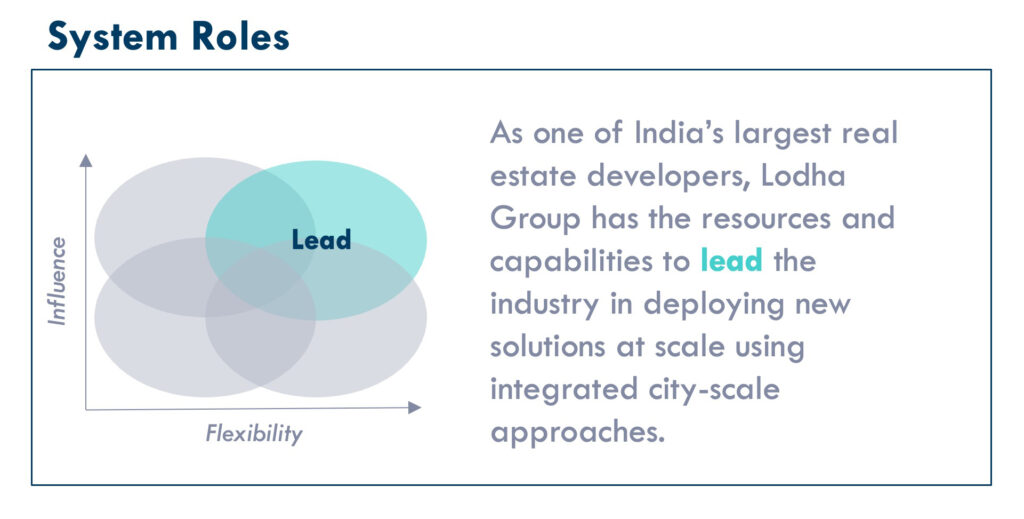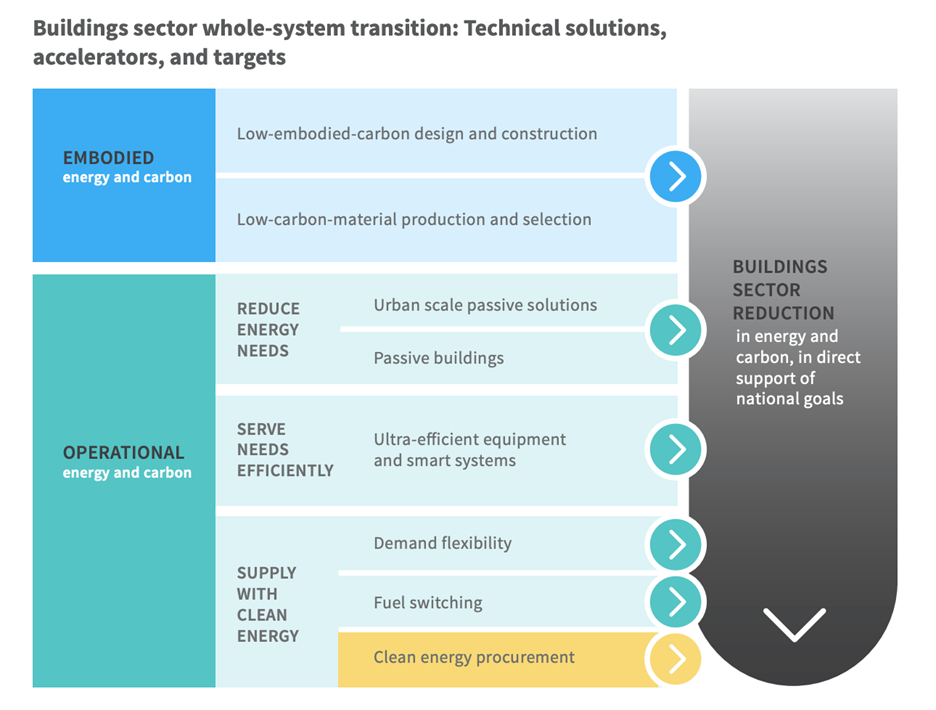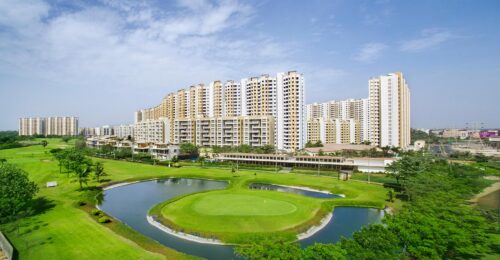
Emergence strategy in Action: Lodha drives sustainable real estate development in India
Case study: How one of India’s biggest real estate developers became a systems leader in green building.
This is the second in a series exploring emergence strategy. For related case studies, click here.
India is the fastest-growing major economy in the world. With rising incomes and rapid urbanization, India could see 400 million new urban dwellers by 2050, a shift that will require massive growth in new building stock. India’s built environment floor space is expected to more than double by 2040 and its real estate industry is expected to reach a $1 trillion market size by 2030 (up from $200 billion in 2021), contributing 13 percent of the country’s GDP by 2025. India’s built environment floor space is expected to more than double by 2040.
From an environmental perspective, a decarbonized buildings sector will be key to India’s sustainable future. Building operations in India account for about a third of its energy use while another 10 percent of the country’s energy is used in the production of building materials and construction of new buildings.
In the absence of energy-efficiency improvements, India’s buildings sector could consume three times more energy in 2050 than it does today while carbon emissions could nearly quadruple. Yet India’s national goals call for reducing its emissions intensity by 45 percent below 2005 levels by 2030 and increasing the share of non-fossil power capacity to 50 percent by 2030.
Lodha (Macrotech Developers Ltd) is a vertically integrated real estate developer and builder, headquartered in Mumbai, India. The largest share of its portfolio is in the Mumbai Metropolitan Region and state of Maharashtra and includes multifamily products ranging from affordable to luxury, as well as commercial projects.
As one of India’s largest real estate developers, Lodha has the financial strength and leadership capacity to implement a strategy that could help India achieve its national objectives for sustainable growth. With a systems-oriented vision, the company aims not only to achieve its own ambitious climate goal of carbon neutrality by 2035, but also to shape the future trajectory of India’s booming real estate development industry.
Explicitly taking a systems leadership role is rare among private companies but, for those that are able, this approach marks one of the boldest and most impactful paths of emergence strategy — setting a new industry standard and being best of class in delivering it.
What is emergence strategy?
Emergence strategy is a way for companies to identify and pursue strategic opportunities in climate action that drive broader systems change while also creating business value for themselves. This is done by applying a set of systems thinking tools to understand what is already happening, where further action is needed, and who is best suited to take those actions.
From the outset, Lodha recognized the importance of the buildings sector to India’s economy overall and the leverage that developers have in driving sustainability through linkages to hundreds of ancillary industries along the value chain. But implementing such a strategy requires a high level of engagement with other stakeholders in the system.
Lodha set out to work with suppliers and customers, government agencies, and experts across different aspects of the business to advance sustainable building construction and operations. Then, in 2022, the company announced the creation of a new platform for learning and connection within this growing community: the Lodha Net Zero Urban Accelerator, an initiative in which RMI participates as a knowledge partner.
Lodha’s approach entails three fundamental elements of emergence strategy:
- System sensing to identify opportunities for profitably delivering sustainable solutions in the context of India’s rapidly growing real estate sector.
- System solutions to overcome barriers based on an understanding of the transformations required in India’s buildings sector and the S-curves of new technologies and design practices and business models that can deliver change.
- System roles developed with an awareness of how Lodha can act and mobilize others to drive and shape systemic change given the company’s unique standing and capabilities.
1. System sensing
Lodha’s leadership recognized the importance of transforming India’s buildings sector and the business opportunity of being at the forefront of this transformation. But they also recognized the attributes of the ecosystem of actors in the buildings space that make transformation challenging: complex supply chains for building materials and challenging learning curves for fundamentally shifting building design and construction practices. Building developers are likely the most important actors to be able to shift this system. If Lodha could do so, they would not only create additional value for their customers but also establish a uniquely strong strategic position for the company going forward.
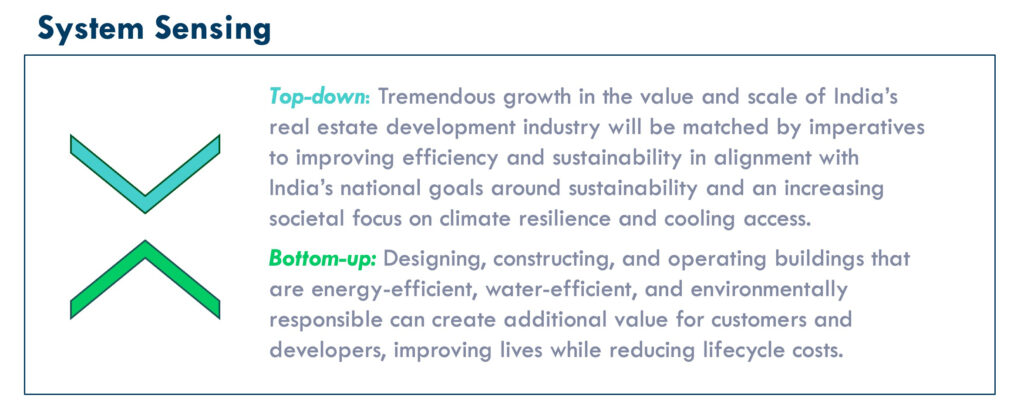
2. System solutions
Lodha quickly focused on the task of strengthening its capabilities — and those of its partners up and down the value chain — to deliver sustainable buildings at scale in the Indian context. As one of India’s largest real estate developers, Lodha has the capacity to create large city-scale developments where the entire spectrum of elements in the built environment can be integrated sustainably. This offers a unique strategic opportunity for rapid-cycle learning, demonstration, and scaling.
Lodha uses its flagship development project near Mumbai, known as Palava, as an integrated, smart city learning lab and a template for sustainable urbanization. Palava has been gradually taking shape on a greenfield site near Mumbai since 2008 and currently entails construction of approximately 50 high-rise buildings annually. Already home to 170,000 residents, Palava is ultimately slated to house a population of more than one million. Palava gives Lodha an opportunity to work holistically on sustainable energy, water, and land use approaches while creating walkable, bikeable communities with green space areas.
In Palava and other projects, Lodha uses a whole systems approach to identify and implement solutions to reduce emissions from its projects, spanning energy and carbon emissions from building construction as well as operational emissions from the building’s use over time.
Source: RMI, Decarbonizing from the Ground Up
Palava’s urban design was found to lower ground temperatures by 2°C compared to surrounding areas, and passive building design provides solar shading and enhances natural ventilation, together offering Palava’s residents’ comfortable temperatures with less need for air conditioning. In its Accelerator initiative, Lodha plans to test new, novel strategies such as highly reflective paints on facades, solar chimneys to improve ventilation, higher performance glazing, and radiant cooling. In addition, Palava’s residents already have more than four megawatts of solar photovoltaic panels installed on the city’s rooftops, enough to largely offset common area energy needs. Buildings are also equipped with solar water heaters that cut the need for fossil-fuel based energy from the grid.
As a result of efficient design and construction, the residential energy use intensity for Palava averages 41 kilowatt hours (kWh per square meter, approximately 30 percent below industry benchmarks after accounting for residential appliances loads. The project has set a target of achieving 25 kWh per square meter.
The Lodha Net Zero Urban Accelerator is a key part of the company’s strategy to rapidly leverage learnings and implement solutions at scale, not only by engaging business partners and customers, but also by strengthening engagement with government agencies and ministries whose actions and standard setting could help to leverage the lessons learned through Palava and other projects.
“Palava positions us quite uniquely to articulate how each aspect of the built environment can be made resilient and low carbon in an integrated manner,” says Aun Abdullah, head of Lodha’s environmental, social, and governance (ESG) initiatives. “With an unprecedented scale of urbanization that’s about to happen in India, it is critical that we can share our work at the accelerator and Palava as a template that demonstrates that growth decoupled from emissions is possible.”
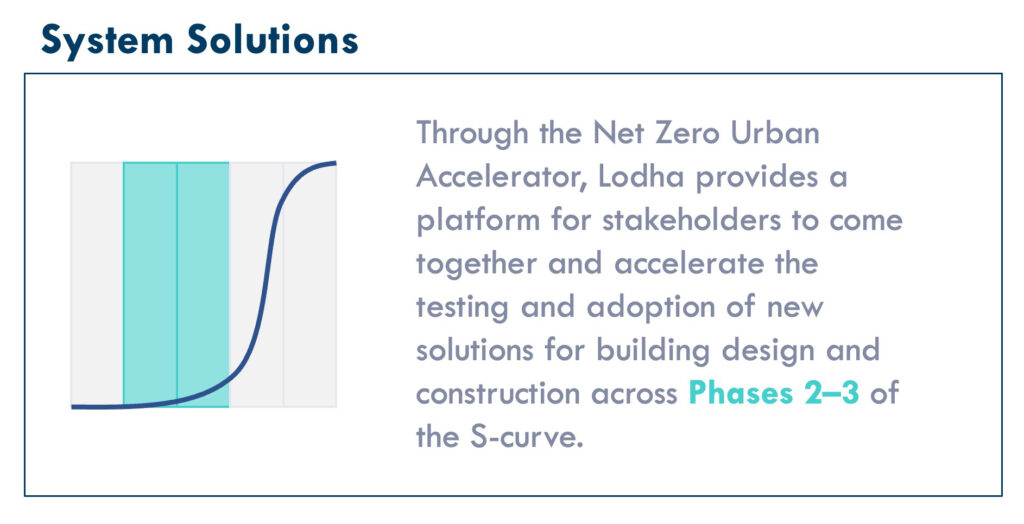
3. System roles
Today, Lodha is able to lead by example in India’s real estate sector, building projects at scale that exemplify sustainable practices while simultaneously seeking to raise the bar toward achieving the company’s long-term goal of net-zero emissions by 2035.
The journey to the top of India’s real estate industry mirrors other systems leaders that emerge not from among the largest players in the sector, but from the second tier — companies large enough to have strategic flexibility but not yet the most influential in the space.
Lodha’s distinctive strategies, aligned to its core mission of “building a better life”, helped the company earn greater influence and scale over time and goes hand in hand with Lodha’s core values. The essence of emergence strategy is the art of recognizing where the need for systems transformation presents business leadership opportunities and how to grasp these opportunities through effective engagement with other stakeholders and partners. Lodha has done both.
